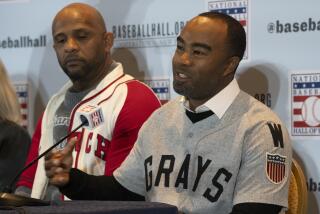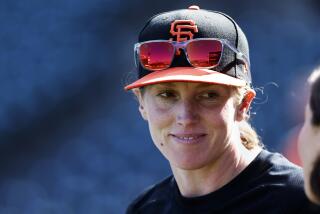Dorothy Kamenshek dies at 84; women’s baseball league star
Former New York Yankee first baseman Wally Pipp called Dorothy “Dottie” Kamenshek “the fanciest-fielding first baseman I’ve ever seen, man or woman.”
Spurred by the personal philosophy that “anything less than my best is failure,” she was known to jump three or four feet in the air and to even do the splits to snag the ball at first base as a player for the All-American Girls Professional Baseball League.
Kamenshek, who had dealt with various health issues since suffering a stroke nine years ago, died Monday at her home in Palm Desert, said Bridget Burden, a friend. She was 84.
The left-handed first baseman and lead-off hitter for the Rockford (Ill.) Peaches was one of the brightest stars of the league, which was founded in 1943 during World War II.
She won back-to-back batting titles in 1946 and ’47 and was the league’s all-time batting leader with a .292 lifetime average. She also was selected to seven All Star teams (1943, 1946-51).
In 1999, Sports Illustrated for Women named Kamenshek No. 100 on its list of the top 100 female athletes of the century.
“She was the greatest ballplayer in our league,” said Pepper Paire Davis, a catcher and 10-year veteran in the league who remained friends with Kamenshek. “She was one of the few ballplayers in our league who hit .300, which is like hitting .400 in the majors.”
Added Davis: “She had the complete game, including the brains. She could hit with power, she could bunt, she could run, she could slide and she played a great defensive first base. She had what I call the three Hs — head, heart and hustle — besides all the talent in the world as a ballplayer.”
Davis, who served as a technical advisor on “A League of Their Own,” the 1992 movie about the league, said the character played by Geena Davis “was symbolically named Dottie as the best ballplayer in the league, and that was after Dottie Kamenshek.”
Davis said Kamenshek, known as Dottie by her fans and Kammie by her friends, “was a great gal, very serious about her baseball. She religiously practiced, but she was a little too serious sometimes. I used to like to make her laugh.”
Kamenshek, whose team won four championships, was such an exceptional player that in 1950, the Fort Lauderdale club of the Class B Florida International League tried to buy her contract. But the girls league board of directors rejected the offer.
League President Fred Leo told United Press at the time that he told the Florida negotiators that “Rockford couldn’t afford to lose her. I also told them that we felt that women should play among themselves and that they could not help but appear inferior in athletic competition with men.”
Not that Kamenshek was interested in making what would have been a historic move.
“I thought at that time it would just be a publicity stunt, and they wouldn’t let me play,” she recently told Marquette Magazine. “So I stayed where I was happy, in Rockford.”
A back injury caused her to leave the league in 1953, a year before its final season.
Kamenshek, who earned a bachelor’s degree in physical therapy from Marquette University in Milwaukee, moved to California in 1961. She worked as a staff physical therapist, supervisor and chief of therapy services for the Los Angeles County disabled children’s services agency.
After retiring from the county in 1980, she treated patients in acute care on a part-time basis for the next six years.
Born in Norwood, Ohio, on Dec. 21, 1925, Kamenshek was a high school senior playing for an industrial league softball team in Cincinnati in 1943 when a scout for the new girls league held tryouts in that city.
Kamenshek was among those selected to participate in the final tryouts at Wrigley Field in Chicago and was one of two Cincinnati girls to join the league.
In the beginning, she told Marquette Magazine, they were “getting only 500 people in the stands, and then it got up to 10,000, which is good for a town that supports minor league baseball. Eventually, we won them over. At first they just came to see the skirts, and then we showed them we could play.”
She never considered herself the best player in the league, she said. “Other people did,” she said. “I just went out and played every game to the best of my ability.”
Baseball, Kamenshek is quoted as saying in “Women at Play: The Story of Women in Baseball,” a 1993 book by Barbara Gregorich, “gave a lot of us the courage to go on to professional careers at a time when women didn’t do things like that.”
She had no immediate surviving family members.
A private funeral will be held.
More to Read
Start your day right
Sign up for Essential California for the L.A. Times biggest news, features and recommendations in your inbox six days a week.
You may occasionally receive promotional content from the Los Angeles Times.






